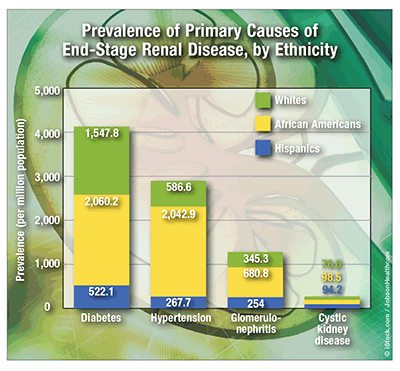US Pharm. 2016;41(8):6.
End-stage renal disease (ESRD), or kidney failure, is the eventual result of chronic kidney disease (CKD), which affects >26 million U.S. adults. In 2014, according to the CMS, more than one-third of ESRD patients received care from a nephrologist for at least a year prior to kidney failure. Major risk factors for ESRD are diabetic nephropathy (43.2%), hypertension (23%), glomerulonephritis (12.3%), and polycystic kidney disease (2.9%).

Incidence and Prevalence: Although the incidence of ESRD rose steadily from 80 in 1980 to 350 in 2001 per million and has since leveled off, there are racial variations. The incidence rose more quickly in African Americans than in all other ethnic groups. However, since 2001, rates have remained stable in all ethnic groups except for American Indians, in whom the rate is declining. In 2014, incidence rates per million were more than two-fold higher in African Americans (1,000) than in Asians (400) and whites (300). From 1980 to 2009, ESRD prevalence increased nearly 600%—from 290 to 1,738 cases per million. At the end of 2009, >871,000 people were being treated for ESRD; 45.8% were receiving dialysis and 19.9% had a working transplanted kidney. More than 10 times as many ESRD patients received hemodialysis treatments at a clinic than those receiving peritoneal dialysis and home hemodialysis combined.
Mortality: In 2014, there were 47,112 deaths from nephritis, nephrotic syndrome, and nephrosis in the U.S., with 14.9 deaths per 100,000. Although the total number of deaths from ESRD has risen since 1980, the rate of increase per year has been dropping after peaking in 2001 (10,478 deaths in 1980 vs. 90,118 in 2009).
Economic Burden: In 2013, total Medicare expenditures (not including prescription medications) for all stages of kidney disease exceeded $99 billion, and $31 billion of this sum was spent annually on treatment of kidney-failure patients. Treatment of ESRD patients cost $42.5 billion in public and private funds.
Diabetes and High Blood Pressure: More than 29 million adults (8.1 million of them undiagnosed) have diabetes—the leading cause of ESRD—and 35% of them have ESRD. Of all ESRD patients, 37% have a primary diagnosis of diabetes. In 2013, diabetes led to >51,000 new cases of ESRD. More than 247,000 patients have diabetes-related ESRD. In 2013, high blood pressure (HBP)—which affects 73 million Americans—led to >33,000 new cases of ESRD. Currently, 165,000 patients have ESRD caused by HBP, which is the second leading cause of ESRD. One-quarter of ESRD patients have a primary diagnosis of hypertension.
To comment on this article, contact rdavidson@uspharmacist.com.






